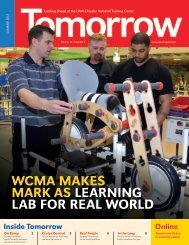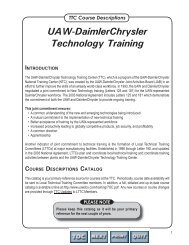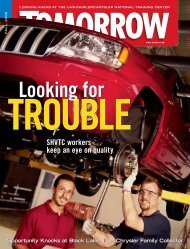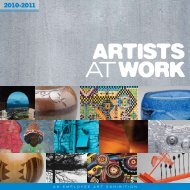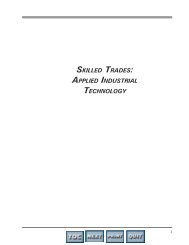2006 Fall Issue - UAW-Chrysler.com
2006 Fall Issue - UAW-Chrysler.com
2006 Fall Issue - UAW-Chrysler.com
You also want an ePaper? Increase the reach of your titles
YUMPU automatically turns print PDFs into web optimized ePapers that Google loves.
Training<br />
UP<br />
WOM PHASE 1 HELPS TEAMS GET SMART<br />
BY OTESA MIDDLETON MILES<br />
LEFT: GETTY IMAGES; RIGHT: JON MURESAN<br />
As the saying goes, there’s no “I” in “team.” And <strong>com</strong>ing<br />
together as a team at the <strong>UAW</strong>-Daimler<strong>Chrysler</strong><br />
Technology Training Center is what the 40-hour Phase 1<br />
Workplace Organization Model (WOM) training is all about.<br />
Darnell Bates, a <strong>UAW</strong> Local 51 member who works at Mack<br />
Avenue Engine II, <strong>com</strong>pleted Phase 1 training in the fall of 2005<br />
as part of the plant’s transition to the Smart Manufacturing team<br />
structure. “It helps all the members get an understanding of what<br />
it is to be an effective team,” says Bates, who started at<br />
Daimler<strong>Chrysler</strong> in 1995 as a part-timer and is now a team leader.<br />
By the end of June, approximately 14,000 workers had<br />
<strong>com</strong>pleted the training. The <strong>UAW</strong>-Daimler<strong>Chrysler</strong> National<br />
Training Center developed the curriculum and coordinated Phase<br />
1 and Phase 2 training. Although most workers are trained at their<br />
locations, some participate at the NTC, the Technology Training<br />
Center or an NTC Regional Family Training Center.<br />
John Stallings, <strong>UAW</strong> coordinator for the training, says the<br />
sessions empower workers. “When you get everybody supporting<br />
each other, it makes a big difference,” he says. “When people<br />
know they play a part in the decision making, it makes them feel<br />
good about what they’re doing.”<br />
ACTIVE LEARNING<br />
The training itself is highly interactive, according to LaMar Harris,<br />
senior process specialist for Union Relations and management<br />
coordinator for WOM training. On Smart teams, the members<br />
make the decisions, which helps the production process move<br />
efficiently. “The goal,” Harris says, “is to produce a quality<br />
product cost-effectively.”<br />
Once a plant begins WOM training, all its workers will<br />
<strong>com</strong>plete Phase 1, which includes two days of training on<br />
“soft” skills, such as <strong>com</strong>munication and conflict resolution.<br />
The first phase also includes two days of technical skills training<br />
and visual management techniques, using sight cues to help coworkers<br />
immediately recognize all standards, including quality<br />
standards, production standards and process standards. With<br />
sight cues, workers should be able to look at any process on the<br />
floor and know, based on the way the area looks, if something<br />
isn’t right — for example, if a fluid level is incorrect.<br />
The Phase 1<br />
WOM is a hot<br />
topic at the <strong>UAW</strong>-<br />
Daimler<strong>Chrysler</strong><br />
Technology<br />
Training Center.<br />
The last day of training simulates a production operation. Using<br />
the new skills they learned in the previous four days of training,<br />
workers transform a problematic operation into a smooth one.<br />
“They use Smart tools and people skills to brainstorm and get<br />
input from everyone,” says Harris. “They improve the process.”<br />
ROLE REVERSALS<br />
Stallings, who has been at <strong>Chrysler</strong> almost 34 years, says he is<br />
excited about the Smart team training because it simplifies<br />
troubleshooting. One big reason it’s easier for Smart teams, he<br />
says, is that team members learn each other’s jobs.<br />
Teams have one leader and an average of four to six members<br />
who frequently rotate duties to understand every role. Job rotation<br />
improves quality because each member knows what should be<br />
happening at each step of the process.<br />
After <strong>com</strong>pleting the training, says Mack II’s Bates, workers<br />
are ready to go back to their plants and put what they’ve learned<br />
into practice. “That will help the <strong>com</strong>pany survive in the<br />
automotive world,” he says. ■<br />
www.uawdcx.<strong>com</strong> TOMORROW FALL <strong>2006</strong> 13






